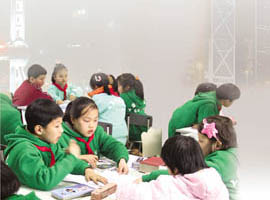Responding to population trends - two approaches
Since the early 1990s, both Hong Kong and Shanghai
have experienced a significant decrease in the number of births. In Hong
Kong, there were more than 68,300 babies born in 1991, but this declined
to 48,200 in 2001, a decrease of nearly 30 percent. The corresponding
numbers for Shanghai were 100,800 and 75,600 respectively (Figure 1).
However, the ways in which the two education systems have responded to
the situation have been markedly different. While Hong Kong has been pre-occupied
with the deployment of "redundant" primary school teachers,
Shanghai has made use of the opportunity to reduce class sizes in a third
of its primary schools.
In 1996, the Shanghai Municipal Education Commission
started promoting small class teaching at primary level. In 1997, only
12 primary schools took part in the scheme. By 2002, 300 out of the 800
publicly-funded primary schools had already implemented small class teaching.
Instead of adopting a mandatory approach, the Government has allowed individual
schools from districts with reduced school populations to apply to join
the scheme.
With the implementation of small class teaching, the average class size in these schools has been reduced from more than 50 students to 20 - 24 students. Each class is provided with an average of 2.5 teachers. In general, one of the teachers is responsible for teaching core subjects including languages and mathematics which take up an average of 13 periods per week.The other one, whose weekly teaching load is on the average 10 periods, performs the role of class teacher and takes charge of general education, extra-curricular activities and student guidance. The remaining 0.5 teacher has an average of seven periods per week and is in charge of cultural subjects like PE, art and music.

The above compares with the situation in Hong Kong
public sector primary schools, where each class is provided with 1.3 to
1.4 teachers, and each teacher has to teach an average of 30 periods per
week with an average class size of 32-35 students.
In Shanghai, the teachers devote the remainder of their time in school to collaborative preparation of lessons and action research. This is also in marked contrast to Hong Kong where the time for teachers to engage in such professional activities is severely limited.